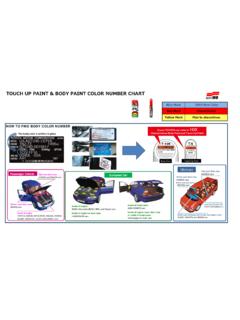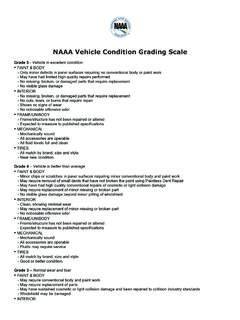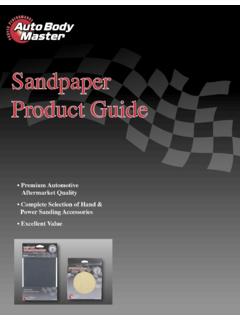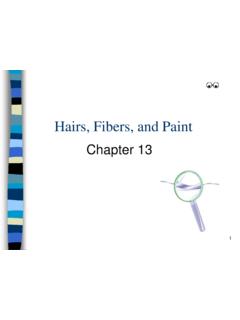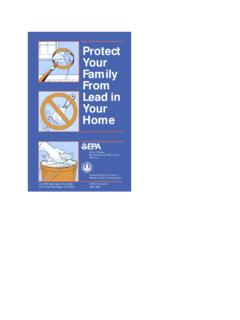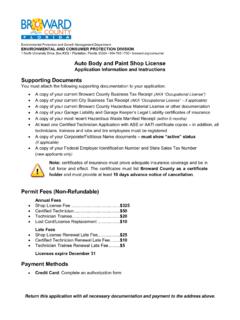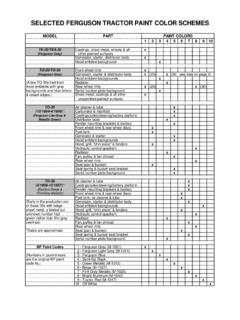Transcription of Corvette Body & Paint Repair Basics
1 Corvette body & Paint Repair Basics by Lars Grimsrud Colorado Corvette Crazies (CCC) The Ultimate Corvette Tuning & Beer Drinking Fraternity Lafayette, CO Rev. C 1-12-03 This tech paper will discuss simple Repair (non-structural) and refinishing processes to produce high-quality results on fiberglass ( Corvette ) panels. Recognize that there are many different product lines out there, and several work techniques for accomplishing body repairs. Different auto body professionals have different preferences as to how to do things, and I may get some disagreement on the specifics of this article. This article will provide you with a group of products and materials, and my personal technique, for accomplishing first-class results. General Vette Info Two different construction techniques have been used to manufacture Corvette body panels over the years.
2 When the Vette made its debut, the new FRP body was a major innovation. Fiberglass Reinforced Plastic was a construction method that could be used to make lightweight panels with curves and design features that could not be easily duplicated in stamped steel. The body was basically built just like a fiberglass swimming pool or a boat hull: A chopgun was used to blow fiberglass strands and resin into a mold that was first coated with resin to produce a smooth surface finish on the body parts. This technique was used through the 1981 model year. 1982 was a unique transition year in many respects. Fuel injection was added to the Vette, and a computer was installed to manage all major engine functions. 82 also saw the advent of a revised body panel construction.
3 Structural Matted Components, or SMC panels, were thinner and lighter due to a laminate construction using more plastic and less glass. This panel type is used on all of our C4 Vettes, and partially on the groundbreaking 82. The composite materials on all Vettes require use of specific techniques and materials. Treating a Vette like a steel car can cause irreparable damage to the body : metal Paint stripping techniques cannot be used, and fillers designed for use on steel will not adhere properly to the FRP or SMC panels. So read on to get the real scoop on the right stuff to Tools required body shops use a lot of air-powered tools in order to speed up repairs and improve profits. All cosmetic bodywork can be performed without the use of air tools, and you will often get better results due to the slower progression of the work.
4 You will, however, need a Paint gun, and you ll need compressed air to power it. Hand Tools Needed File Board A File Board isn t a file at all: it s a long backing board with handles for mounting long strips of sandpaper, called file sheets. The length and stiffness of the file board allows you to produce perfectly smooth, straight panels and repairs. It s the most important tool you ll use in the Repair and refinishing of your Vette. The most common Boards are molded hard rubber, and require use of sticky-backed sandpaper. I personally prefer the old style wooden ones with metal clips securing the sandpaper: they allow me to use either sticky-backed or standard sandpaper. Cost of a wooden File Board with clips is about $25. They are available at all body and Paint supply stores.
5 The long ones, which I highly recommend, are 16 long and 2-1/2 wide. Sanding Block In addition to your File Board, you ll need a small, rubber sanding block. These soft, flexible black rubber blocks are about 3/8 thick, and measure 2-1/2 wide by 5 long. These dimensions allow you to tear a piece of standard sandpaper in half and wrap it perfectly around this semi-flexible block. You ll use it to do all of your finish sanding and color sanding (discussed later). Filler Handling/Mixing Tools To mix and apply any body fillers, you ll need a flat plate and a spatula/spreader. Flat plastic/nylon mixing plates and spreaders are available from your body & Paint supply store, but I just use a flat piece of aluminum plate that measures about a foot square, and the Paint supply store gives me a handful of the low-cost yellow plastic spreaders.
6 Paint Mask All of the Paint supply places carry low-cost, disposable, cartridge-type Paint masks. They work great, you don t have to throw them away after use, and they re cheap. Get one. Power Tools Needed Paint Gun A topic all to itself, Paint guns come in a huge range of qualities, types, and prices. For home use, there are two basic types: Suction Feed and Gravity Feed. The Suction Feed gun is the Paint gun we re all used to seeing: it has a detachable Paint cup slung underneath, and operates by siphoning the Paint up from the cup and into the discharge nozzle. These are the most economical guns, and can produce quite acceptable results. Economy versions, which are spin-offs and near-duplicates of the top-end name-brand guns, can be found at Buyer s Club, Eagle Hardware, Pace Membership Warehouses, and other hardware stores.
7 Prices range from about $25 - $75. I have actually painted complete cars with a $35 siphon feed generic Paint gun with outstanding results. Disadvantage of these econo-guns is that they cannot be rebuilt (replacement parts are generally not available), you cannot change nozzle and tip sizes (various sizes not available), and they wear out faster than the high-end name-brand guns. I still have my $35 gun that I bought over 10 years ago, and my son is now using it to Paint his car. There are also name-brand, better-quality siphon feed guns made by Snap-On, Devilbiss, Sharp, and others. These guns can be rebuilt indefinitely, lots of parts are available, and they produce excellent results. Overall disadvantage of the siphon feed guns is that not all of the Paint in the Paint cup is usable: they will quit spraying while there is still of Paint in the cup.
8 Also, as Paint level gets low, they will occasionally Paint intermittently as the siphon tube is uncovered during the painting process. Clean-up is a bit of a mess, as there will be some Paint to dispose of. Yet, I would recommend one of these econo-guns to the beginner, as they will perform quite well for the $$. The gravity-feed gun is what is primarily used in the industry. Most of the gravity feed guns are also what are known as High Volume Low Pressure, or HVLP. The key characteristic about these guns is that the Paint cup is mounted on top of the Paint gun instead of underneath. This produces a very uniform flow of Paint to the discharge nozzle, allowing use of lower air pressure (and lower Paint emissions from overspray). It also allows all of the Paint in the cup to be used, and simplifies cleanup.
9 Good, econo-versions are available, but at a higher price than the econo-version of the siphon feed guns. All of the major Paint gun manufacturers make gravity feed guns, and they are excellent quality. We use them exclusively at our restoration facility, but I still use my siphon feed guns at home. If you have $200 to spend, buy a gravity feed instead of a siphon feed. Compressor Here you want something that will keep up with your Paint gun and not drop off significantly in pressure while you re painting. This requires at least 5 horsepower. I ve seen guys do it with 3-horse, but it won t keep up continuously with a Paint gun. If you have a 220-volt outlet in your garage, go with the 220 power, otherwise you ll have to do with a 120-volt unit. Compressors of this size are always on sale at the big hardware chain stores.
10 Look for a deal. I ve been running a 5-horse, 120-volt Craftsman for the past 15 years with great success. I can sure tell on my utility bill when I m painting a car, Buffer To finish off your Paint job, you ll need to be able to buff it out. Don t do this by hand: Get an electric buffer. Your Paint supply store can then sell you a good foam pad to go on it. Consumable Supplies These are the basic consumables you ll need no matter what kind of car you re doing: Econo-Grade Lacquer Thinner For general clean-up, get at least a one-gallon can of the econo-grade stuff. You ll use it to clean up your filler application tools as well as your Paint gun. The Paint supply stores actually sell stuff labeled as econo-grade thinner, and it s cheap.

